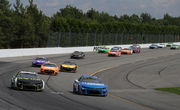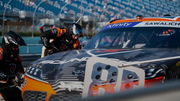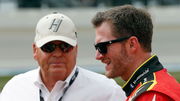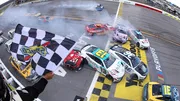
via Getty
INDIANAPOLIS, INDIANA – JULY 20: Kyle Busch, driver of the #8 Cheddar’s Patriotic Chevrolet, waits on the grid during qualifying for the NASCAR Cup Series Brickyard 400 at Indianapolis Motor Speedway on July 20, 2024 in Indianapolis, Indiana. (Photo by James Gilbert/Getty Images)

via Getty
INDIANAPOLIS, INDIANA – JULY 20: Kyle Busch, driver of the #8 Cheddar’s Patriotic Chevrolet, waits on the grid during qualifying for the NASCAR Cup Series Brickyard 400 at Indianapolis Motor Speedway on July 20, 2024 in Indianapolis, Indiana. (Photo by James Gilbert/Getty Images)
Everyone knows sportspersons, especially motorsports drivers, for their fiery passion and unfiltered emotions. They don’t hold back when they feel wronged, and the pressure of competition often leads to candid remarks. Take the recent incident with Max Verstappen, for example. The 4x F1 king didn’t mince words when referring to the Abu Dhabi stewards as “stupid idiots” after receiving a 10-second penalty for causing a collision with McLaren’s Oscar Piastri. The remark came after Verstappen spun both drivers at the opening corner of the season finale at Yas Marina Circuit.
A similar situation unfolded after the 2025 Daytona 500, where Kyle Busch took to X, expressing frustration over NASCAR’s Damage Vehicle Policy (DVP). His tweet read: “Parked by @nascar officials. Rule says you have 3 attempts to make minimum speed. The race never went back green yet. I don’t even think they know their own rules or procedures. 🤬” However, Tommy Baldwin, majority owner of Tommy Baldwin Racing and Competition Director of Rick Ware Racing, showed a different perspective.
ADVERTISEMENT
Article continues below this ad
Tommy Baldwin unpacks the Kyle Busch controversy
This week on the Door Bumper Clear podcast, Bubba Wallace joined Freddie Kraft, Tommy Baldwin, and Karsyn Elledge to break down the highs and lows of Speedweeks at Daytona. One of the major talking points was the updated Damaged Vehicle Policy (DVP). They discussed its controversial impact on Richard Childress Racing (RCR) driver Kyle Busch‘s race and eventual result at the Daytona 500.
Tommy Baldwin provided key insight into the DVP’s implications. Especially regarding the change that allows cars to rejoin the race after repairs in the garage. He explained, “Last year, the car was allowed to possibly get towed to pit road and then you were on a 7-minute clock. An 8-minute clock at Atlanta, and you were allowed 7 minutes in order to fix it” He then highlighted the shift from time-bound repairs on pit road to a more lenient repair process in the garage. It means the teams will have more flexibility but less accountability regarding the duration of repairs.
Baldwin also addressed the nuances of the new system, which ultimately led to Busch’s disappointing result, saying, “He went out under caution and then came back in cause it was still problems, but still you went back out.” Freddie Kraft agreed, “So, he needed to stay out, stay out, make minimum, and then come back and work on it.”

via Imago
LAS VEGAS, NV – OCTOBER 19: Kyle Busch 8 Richard Childress Racing FICO Chevrolet answers questions from members of the media during a media bullpen before practice and qualifying for the South Point 400 NASCAR, Motorsport, USA Cup Series playoff race on October 19, 2024, at Las Vegas Motor Speedway in Las Vegas, NV. Photo by Marc Sanchez/LVMS/Icon Sportswire AUTO: OCT 19 NASCAR Cup Series South Point 400 EDITORIAL USE ONLY Icon144241019026
Baldwin further explained, “If it made minimum speed, then he could have went on pit road, and no more, no more clock, no more anything, and work on the car.”
During the race, however, Busch wasn’t able to make the minimum speed in the garage area since the race was still under caution. NASCAR officials ordered him to return to the pits for necessary repairs on his car. But, once in, they prevented him from going back out again. It’s simply because he hadn’t met the minimum speed requirements earlier, per the new DVP rules. Busch ultimately finished in a disappointing 34th place, marking a poor start to the 2025 season. This was his first in 19 years without a race win in the Cup Series.
Top Comment by
yes, they need to change the rule as it used to be tape it up and go
Share your take
As NASCAR rolls out these updates in the 2025 season, drivers and teams are still adapting. Baldwin’s commentary underlines that while these rules aim to give teams a fair chance, they can create frustrating situations. Especially when race outcomes get influenced by procedural technicalities rather than driver performance.
Trending
ADVERTISEMENT
Article continues below this ad
NASCAR defends its DVP amid backlash from stakeholders
NASCAR stood firm in defending the decision surrounding Kyle Busch’s disqualification. Officials explained the reasoning behind the new DVP rules. They clarified, “Under DVP rules, a driver can only leave the garage once to reach minimum speed. Since Busch left and never met the requirement, he wasn’t allowed to go back to the garage for further repairs. The only exception would have been refueling.”
In simpler terms, Busch couldn’t return to the garage for additional work. All because he didn’t meet the minimum speed requirement after re-entering the track under yellow.
Looking ahead, Busch’s next challenge comes at the Ambetter Health 400. Starting Atlanta, he is shifting his focus back to the NASCAR CRAFTSMAN Truck Series in 2025. The driver, who holds the record for the most wins in the Truck Series with 66 victories, will return to Spire Motorsports for a five-race campaign. This move marks an exciting chapter in Busch’s pursuit of reclaiming his winning form.
ADVERTISEMENT
Article continues below this ad
On the other hand, Busch’s Daytona disaster has quickly become the biggest controversy of Speedweeks. It raises a crucial question: Should NASCAR reconsider the DVP rules to account for caution periods?
Shouldn’t they have allowed him to wait for the next green-flag lap before being parked if Kyle Busch had three attempts to reach minimum speed? His frustration is understandable. NASCAR may need to revisit the policy to prevent a similar fate for another high-profile driver.
ADVERTISEMENT
ADVERTISEMENT
ADVERTISEMENT
ADVERTISEMENT







Should NASCAR rethink its DVP rules to prevent more driver frustrations like Kyle Busch's?